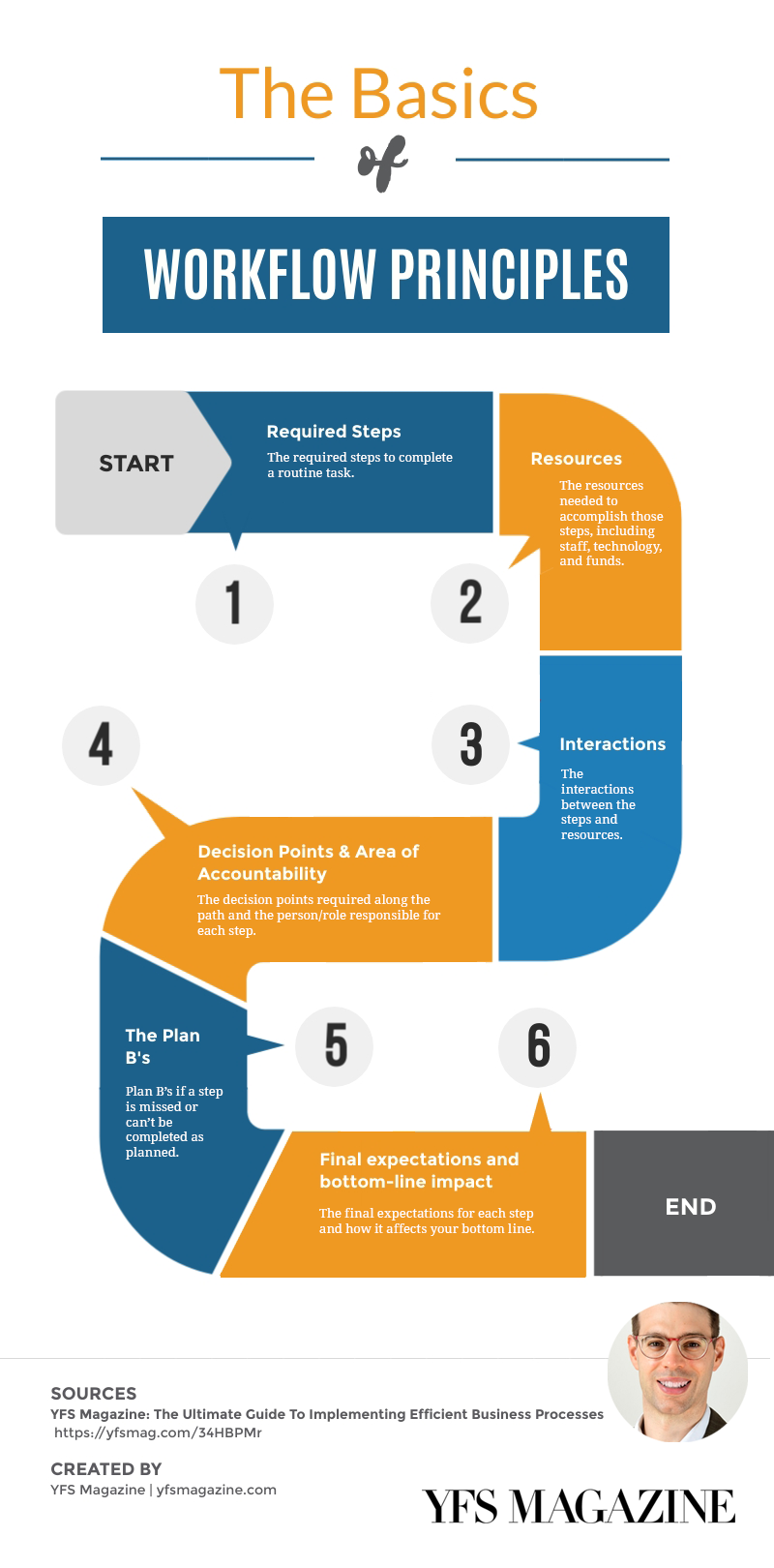
To compete in your industry on a level playing field, you must increase efficiency and productivity across your business. However, if you spend all day delegating tasks that should be automated so departments and employees can work efficiently, there’s a disconnect in your workflow.
When an entire department’s output is held-up for one person to finish their part, projects are delayed, and productivity is stalled. If this is prevalent in your business, it’s time to take a few steps back and implement more practical work processes.
An efficient workflow design ensures that your employees know how to streamline, organize their tasks, and eliminate work that doesn’t serve a shared goal.
If your employees aren’t organized, your bottom line is suffering, and the consequences of disorganization spread quickly. With better, more efficient business processes, all departments and employees can work under less stress, with clear guidelines of what is expected and what to do when a setback occurs.
The benefits of a daily workflow
If you show up to the office and your team is lined up waiting to tell you about problems and get your input, you aren’t working and neither are they. Even worse, those same employees may sit for days stuck and not ask for help.
Chances are other due dates sneak up on them while they are at a stand-still. But an effective workflow process lets them know where to go and who to turn to for help, establishing leadership systems that keep projects moving smoothly.
Is your workflow scalable and efficient?
A workflow is an organized, clear picture of the best practices to get a job done. When running your business, a workflow is used to streamline jobs into peak efficiency.
For instance, any task that has steps, like cooperation between coworkers or colleagues, is evaluated for its current processes and how it could be completed more effectively. In short, it’s a breakdown of the small components that create an outcome, allowing you to determine which steps create bottlenecks.

Of course, deploying a new process isn’t a simple, overnight effort. To truly create results that work for your company, you’ll need to invest time into analyzing what currently works and what doesn’t, test and adjust your changes, and troubleshoot issues. You will likely encounter resistance from employees who don’t handle change well. But once you create a system that works and see it in action, you and your team will be hooked by the results.
Scalable, efficient processes are necessary for business owners who want to optimize their work. These business processes streamline work methods across every interconnected department to make the entire organization run like a well-oiled machine with contingencies in the event that complications arise in the planned system; there are procedures in place to prevent activity from stopping, so team members can quickly find a solution to continue their work.
How to create an efficient workflow
Improved business processes are not something you can jump in and create without planning or forethought. There are steps you should take to ensure your attempts will work consistently. If you aren’t careful with your design, you could jeopardize the entire operation.
A single workflow that contains an error can cause destructive inefficiencies for your company’s bottom line. Instead of performing a company-wide rollout as the first step with a new process, implement your improved workflow in a testing stage with one or two departments to work out any bugs.

It takes a lot of work to understand current inefficiencies and how to implement a company-wide business process that eliminates bottlenecks. To prevent consequences for productivity and growth, don’t attempt to evaluate and improve workflows on your own. There are professional online courses and videos on the subject that can guide you
Basic principles behind work processes
No matter how you go about it, seek to understand the basic principles behind work processes before you begin. To put your workflow together, consider the following aspects of your current procedures and processes for completing projects.
- The required steps to complete a routine task
- The resources needed to accomplish those steps, including staff, technology, and funds
- The interactions between the steps and resources
- The decision points required along the path
- The person responsible for each step
- Plan B’s if a step is missed or can’t be completed as planned
- The final expectations for each step and how it affects your bottom line

5 steps to implement an efficient business process
With these ideas in mind, you can use five detailed steps to implement a more efficient business process:
1. Analyze what you’re doing now
What you’re doing may work to some degree, but perhaps not as well as it could. Complete a thorough analysis to determine how you currently operate and critique your strategy. What are the most significant inefficiencies? What might be causing them?
You should also investigate the steps taken when your team hits a dead end. What tools do they currently use to track deadlines and stay on top of them? Is there a visual representation, or roadmap, for each task? Talk to your colleagues and employees to get feedback that can help you create streamlined processes.
2. Determine your focus areas
After your analysis is complete, decide where you have room for improvement. What factors are causing weak links between the input to output? Is cash flow being hindered? What is working well and shouldn’t be touched? Break these areas down department by department.
Find one department to focus on as you begin creating your new processes –– perhaps an area that needs some help but is not your biggest problem. That way, you can approach issues that might arise, such as employee roadblocks and cash flow concerns, while continuing to be productive.
3. Break it down step-by-step
Even if the next step in a task appears to be obvious, break down each section into smaller, traceable steps. If there’s a better way to do something, replace the obsolete step. Keep it simple and focus on the outcome.
As you break down each point, give it a number in terms of importance. Which steps are crucial to the outcome, and which must be done to get to the next? Keep an eye on the necessary processes, but don’t neglect the minor steps. The foundation of a house doesn’t put a roof over anyone’s head, but without it, the entire structure collapses.
4. Document each step and automate it
Relying on memory to ensure everything gets done leaves room for failure. If you have a sleepless night, get a little too stressed, or forget, that critical task can get skipped. With visual documentation of each step, you ensure the process you worked so hard to perfect works.
As part of your work process system, there should be a central area where the steps are prominently displayed. Department heads can track and manage their processes through a work management software that analyzes data and communicates results, which helps everyone tweak steps and become more productive.
5. Test, tweak and implement your work processes
Put your plan into action to test its effectiveness. Be open to suggestions from others who are involved in the outcome. If your work process doesn’t operate perfectly the first few times, have patience. Each adjustment makes it better.
Once you’ve optimized efficiency, look for ways to continually refine it. Complacency often stifles businesses as new technology and competitors enter the scene. Your workflow can always be optimized; it’s up to you to put in the work and execute the plan.
Work smarter, not harder
There’s no way to create a perfect scenario for work processes the first time. You’ll always adjust to new variables. But as you learn, instead of constantly spinning your wheels to stay on the playing field, you’ll be focused on getting ahead.
With work processes management software and business courses, open-minded analysis, and collective ideas, you can create an efficient system that works, so you can work smarter, not harder.
Tom Casano is the founder and CEO of Life Coach Spotter and Sure Oak. He’s also a public speaker, crypto enthusiast, podcast host, growth trainer, and dad. Before all this, he built his first website at the age of 13 (in 1997) and spent ten years trading in the stock market. Connect with @tomcasano on Twitter.
© YFS Magazine. All Rights Reserved. Copying prohibited. All material is protected by U.S. and international copyright laws. Unauthorized reproduction or distribution of this material is prohibited. Sharing of this material under Attribution-NonCommercial-NoDerivatives 4.0 International terms, listed here, is permitted.











